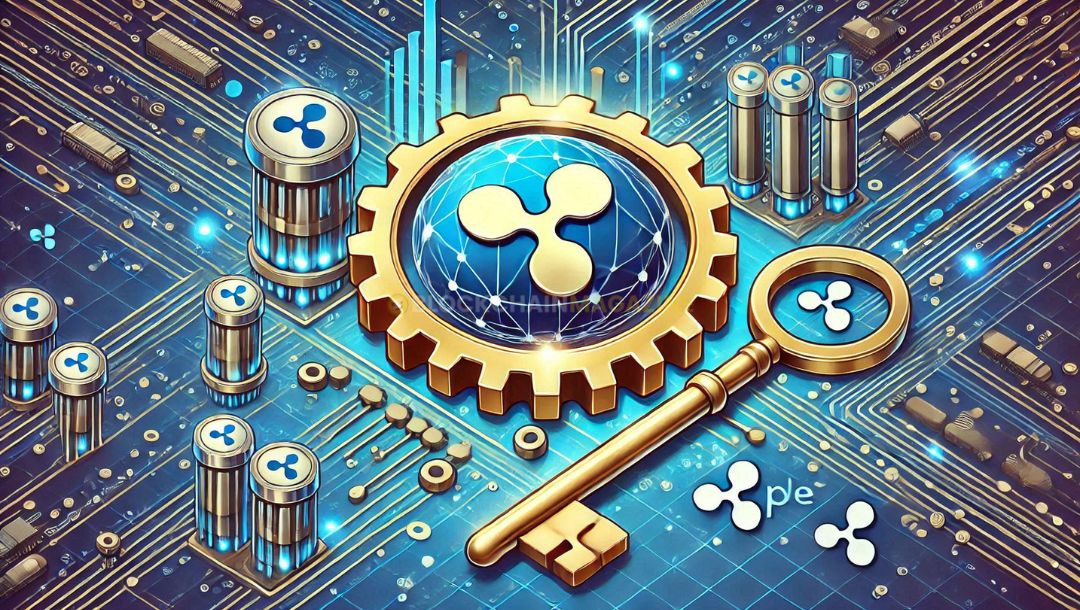Chainlink Crypto & Ripple: The CRYPTO REVOLUTION You Can’t Miss!
Hey there, crypto enthusiasts! Ever wondered what’s shaking up the crypto world right now? Well, it’s all about Chainlink and Ripple. These two are making waves and changing the game in ways you wouldn’t believe. Chainlink is all about connecting real-world data to blockchain systems, while Ripple’s XRP is transforming how we think about cross-border payments. Let’s dive into how these two powerhouses are leading the charge in the crypto revolution.
Key Takeaways
- Chainlink connects real-world data to blockchain, making smart contracts smarter.
- Ripple’s XRP is revolutionizing cross-border payments, making them faster and cheaper.
- Both Chainlink and Ripple are at the forefront of the crypto revolution, driving innovation.
- Investing in Chainlink and Ripple could be a smart move as they continue to grow and impact the market.
- The partnership and synergy between Chainlink and Ripple might redefine the future of crypto.
Chainlink Crypto: Bridging Real-World Data with Blockchain
Understanding Chainlink’s Oracle Network
Chainlink’s oracle network is like the unsung hero of the blockchain world. It connects smart contracts to real-world data, making them way more useful. Imagine a smart contract that needs to know the weather to trigger a payout for a crop insurance policy. Chainlink steps in, grabbing that data and feeding it to the blockchain. It’s this bridging of digital and physical worlds that sets Chainlink apart.
The Role of Chainlink in Smart Contracts
Smart contracts are cool and all, but without real-world data, they’re kinda limited. Chainlink changes the game by providing reliable data inputs. This means a smart contract can automatically adjust a loan interest rate based on current market conditions or execute a trade when a stock hits a certain price. Chainlink’s role is crucial here, ensuring data is accurate and tamper-proof.
Chainlink’s Impact on Blockchain Infrastructure
Chainlink isn’t just a tool; it’s part of the backbone of blockchain infrastructure. By providing secure and reliable data feeds, it enhances the functionality of decentralized applications (dApps) across various industries. Whether it’s DeFi, insurance, or supply chain management, Chainlink’s impact is felt far and wide.
Chainlink’s integration into the blockchain ecosystem represents a significant step toward a more interconnected and efficient digital future. Its ability to bring off-chain data onto the blockchain is transforming how businesses operate and innovate.
Ripple’s XRP: Revolutionizing Cross-Border Payments
How XRP is Transforming International Transactions
Ripple’s XRP is shaking up the world of international finance by offering a fast, cost-effective alternative to traditional banking systems. With its On-Demand Liquidity (ODL) service, XRP eliminates the need for pre-funded accounts, making cross-border payments smoother and quicker. This innovation not only cuts down transaction times but also reduces costs significantly, making it a preferred choice for financial institutions looking to streamline their operations.
The Future of Ripple in the Financial Sector
The future looks promising for Ripple, especially with its recent developments. The launch of Ripple’s new stablecoin, approved by the New York State Department of Financial Services, marks a significant step forward. This stablecoin is set to be available for trading starting Tuesday, adding another layer to Ripple’s expanding suite of financial tools. As Ripple continues to forge partnerships with major banks and financial entities, its role in the financial sector is expected to grow, potentially leading to broader adoption of its technologies.
XRP’s Role in the Crypto Ecosystem
XRP plays a crucial role in the broader crypto ecosystem by facilitating seamless value transfers across borders. Its efficiency and scalability make it a vital component for crypto exchanges and financial platforms. As more businesses and consumers turn to digital currencies for everyday transactions, XRP’s utility and influence are likely to expand, further cementing its position as a key player in the crypto revolution.
Ripple’s commitment to enhancing cross-border payment solutions is evident in its continuous innovation and strategic partnerships. As the financial landscape evolves, Ripple and XRP are poised to lead the charge in creating a more connected and efficient global economy.
The Synergy Between Chainlink and Ripple
Collaborative Innovations in Blockchain
When it comes to blockchain, both Chainlink and Ripple are making strides. Chainlink is known for its oracle network, which brings real-world data to blockchain systems. On the other hand, Ripple focuses on cross-border payments. Together, these two can create a powerful alliance in the blockchain world. Imagine a system where Ripple’s payment solutions are enhanced by Chainlink’s reliable data feeds—this could lead to more efficient and secure transactions.
Enhancing Security and Efficiency
Security and efficiency are key in the blockchain space. Chainlink provides trustworthy data feeds that can improve the security of smart contracts. Ripple, with its fast transaction speeds, can benefit from this by ensuring that its cross-border payments are not just quick but also secure. This collaboration could redefine how transactions are processed globally.
The Future of Chainlink and Ripple Partnership
Looking ahead, the partnership between Chainlink and Ripple could open new doors for blockchain technology. They have the potential to influence not just the crypto market but also traditional financial systems. As more industries adopt blockchain, the combined strengths of Chainlink’s data solutions and Ripple’s payment technology could lead to groundbreaking advancements.
The collaboration between Chainlink and Ripple isn’t just about technology—it’s about transforming the way we think about transactions and data security. The future looks promising as these two giants work together to push the boundaries of what’s possible in blockchain.
Investment Opportunities in Chainlink Crypto
Why Chainlink is a Top Altcoin to Watch
Chainlink is not just another cryptocurrency; it’s a major player in the blockchain space, especially with its unique oracle technology. This technology connects smart contracts with real-world data, making blockchain applications more versatile and practical. As industries increasingly rely on smart contracts, Chainlink stands out as a key enabler, which keeps it relevant and promising for investors.
Potential Growth and Market Trends
The current market price of Chainlink is around $11, but projections suggest it could hit $30 by 2025. This growth isn’t just speculation; it’s backed by Chainlink’s ongoing advancements in staking and its partnerships with big names in various sectors. Here’s a simple breakdown of what an investment could look like:
| Investment Amount | Price per LINK | Number of LINK Tokens | Value if LINK Reaches $30 |
|---|---|---|---|
| $8,500 | $11 | ~773 | $23,190 |
How to Invest in Chainlink Effectively
Investing in Chainlink requires a bit of strategy. Here are some steps to get you started:
- Research and Stay Informed: Keep up with the latest news about Chainlink’s projects and partnerships.
- Choose a Reliable Exchange: Use trusted platforms to buy and store your LINK tokens.
- Diversify Your Portfolio: Don’t put all your money into one asset. Balance your investments to manage risk effectively.
The crypto market is unpredictable, but Chainlink’s strong foundation and continued innovation make it a compelling choice for those looking to invest in the future of blockchain technology.
Ripple’s Strategic Moves in the Crypto Market
Ripple’s Recent Achievements and Developments
Ripple has been on a roll lately, and it’s hard to ignore the buzz around its recent moves. One of the standout achievements is the launch of its RLUSD stablecoin, which is already making waves in the crypto space. This stablecoin is designed to facilitate smoother and more efficient transactions, especially in cross-border payments. Ripple’s focus on expanding its partnerships has also played a significant role in its recent success. By collaborating with financial institutions worldwide, Ripple has strengthened its position as a leader in the crypto market.
The Impact of Regulatory Changes on Ripple
Navigating the regulatory landscape has always been a challenge for cryptocurrencies, and Ripple is no exception. Recent changes in the regulatory environment, particularly in the U.S., have had a noticeable impact on Ripple’s operations. With a more crypto-friendly administration in place, Ripple is optimistic about the future. The potential approval of an XRP ETF is a significant development that could open new doors for Ripple and its investors. However, the company remains cautious and continues to work closely with regulators to ensure compliance and foster a positive relationship.
Future Prospects for Ripple Investors
For investors, the future of Ripple looks promising. The company’s strategic moves and recent successes have positioned it well for growth. Here are a few reasons why Ripple might be a good investment opportunity:
- Innovative Products: With the introduction of RLUSD and other financial products, Ripple is set to revolutionize the way transactions are conducted.
- Regulatory Progress: The possibility of an XRP ETF and favorable regulatory conditions are encouraging signs for investors.
- Strong Partnerships: Ripple’s collaborations with major financial institutions give it a competitive edge in the market.
Ripple’s journey in the crypto market is one of resilience and strategic foresight. As the company continues to innovate and adapt, it holds the potential to redefine the landscape of digital finance.
The Crypto Revolution: Chainlink and Ripple Leading the Way
Key Innovations Driving the Revolution
Chainlink and Ripple are at the forefront of the crypto world, each bringing unique innovations that are reshaping how we think about digital assets. Chainlink, with its robust oracle network, bridges real-world data with blockchain, making smart contracts more reliable and versatile. Meanwhile, Ripple’s XRP is streamlining cross-border payments, making transactions faster and cheaper. Together, these technologies are paving the way for a more interconnected and efficient digital economy.
The Role of Chainlink and Ripple in the Crypto Landscape
In the vast crypto landscape, Chainlink and Ripple have carved out pivotal roles. Chainlink’s oracles provide critical data feeds that power DeFi applications, while Ripple’s payment solutions are gaining traction among financial institutions worldwide. This synergy between data accessibility and transaction efficiency is what makes these two projects stand out. Blockchain’s potential is being realized through their combined efforts, offering solutions that are both innovative and practical.
What the Future Holds for These Cryptocurrencies
Looking ahead, the future for Chainlink and Ripple appears bright. Chainlink continues to expand its data services, integrating with more blockchains and enhancing its security protocols. Ripple, on the other hand, is navigating regulatory landscapes to further its reach in the financial sector. Both are likely to play significant roles in the evolution of blockchain technology, driving forward the next wave of digital transformation.
The ongoing advancements in blockchain technology, led by pioneers like Chainlink and Ripple, suggest a future where financial systems are more transparent, efficient, and accessible to all.
Chainlink’s Influence on DeFi and Beyond
Chainlink’s Role in Decentralized Finance
Chainlink is like the backbone of DeFi—it connects smart contracts to real-world data, making them smarter and more reliable. Imagine a world where loans are given out automatically based on real-time credit scores or insurance claims are processed instantly after a natural disaster. Chainlink makes this possible by feeding accurate data into these systems. Its ability to provide secure and tamper-proof data is transforming how financial services operate on the blockchain.
Expanding Use Cases for Chainlink
Beyond just finance, Chainlink’s technology is spreading to other industries too. Think about supply chains that can track products from start to finish, or gaming platforms that can verify in-game achievements with real-world rewards. Chainlink’s oracles are the key to these innovations. They’re like bridges, connecting blockchain with the outside world, ensuring that data is not only accurate but also trustworthy.
The Future of Chainlink in the DeFi Space
Looking ahead, Chainlink’s impact on DeFi is set to grow even more. As the DeFi space evolves, the demand for reliable data will only increase. Chainlink is already working on new features like staking, which could make its network even more secure and attractive to users. With the rise of decentralized applications, Chainlink is poised to play a crucial role in shaping the future of digital finance.
Chainlink’s recent price surge has sparked debate over its sustainability, with a notable 40% increase attributed to active dormant wallets and positive market sentiment. However, the high open interest in derivatives raises concerns about overleveraged positions and potential liquidations. Technical indicators like Fibonacci levels and MACD suggest bullish momentum, but a divergence between price and momentum hints at a possible bull trap. Traders are advised to remain cautious and monitor market signals closely. c1fc
Ripple’s Vision for a Decentralized Financial Future
Ripple’s Approach to Decentralization
Ripple has always been at the forefront of pushing boundaries in the crypto world. Their approach to decentralization is not just about removing middlemen but ensuring that financial systems are more accessible and efficient. By leveraging blockchain technology, Ripple aims to create a network where transactions are not only faster but also more transparent. This vision aligns with the broader goal of decentralization, where power is distributed rather than concentrated.
The Impact of Ripple’s Technologies on Global Finance
Ripple’s technology, particularly its On-Demand Liquidity (ODL) service, is transforming how money moves across borders. ODL eliminates the need for pre-funding in cross-border payments, significantly reducing costs and time. This innovation is crucial for businesses and individuals who rely on international transactions. As Ripple continues to partner with major financial institutions, its impact on global finance becomes even more pronounced. The growing adoption of Ripple’s technology signals a shift towards more efficient and inclusive financial systems.
Challenges and Opportunities for Ripple
While Ripple is making strides in decentralizing finance, it faces challenges, particularly in the regulatory landscape. Navigating these regulations is critical for Ripple’s continued success and expansion. However, with challenges come opportunities. The potential approval of an XRP ETF could open new avenues for investment and adoption. As Ripple continues to innovate and adapt, it stands poised to play a significant role in shaping the future of finance.
Ripple’s journey towards decentralization is not just about technology but about reshaping the financial landscape to be more inclusive and efficient. As they tackle regulatory hurdles and explore new opportunities, Ripple remains a key player in the crypto revolution.
Conclusion
In the ever-evolving world of cryptocurrency, Chainlink and Ripple are making waves that you just can’t ignore. These two digital assets are not just reshaping the crypto landscape; they’re setting the stage for what’s next. Chainlink, with its ability to connect smart contracts with real-world data, and Ripple, pushing the boundaries of cross-border payments, are both paving the way for a new era in finance. As we watch these developments unfold, it’s clear that the crypto revolution is far from over. Whether you’re a seasoned investor or just getting started, keeping an eye on these innovations could be key to understanding the future of digital currency. So, stay curious and keep exploring, because the crypto world is full of surprises.
Frequently Asked Questions
What is Chainlink and how does it work?
Chainlink is a technology that connects real-world data to blockchain networks. It acts like a bridge, allowing smart contracts on the blockchain to use data from outside sources.
Why is Ripple’s XRP important for international payments?
Ripple’s XRP is used to make cross-border payments faster and cheaper. It helps banks and financial institutions move money across countries quickly and with low fees.
Can Chainlink and Ripple work together?
Yes, Chainlink and Ripple can work together to improve blockchain technology. By combining their strengths, they can create more secure and efficient systems.
Is investing in Chainlink a good idea?
Investing in Chainlink can be a good idea because it plays a big role in blockchain infrastructure. However, like all investments, it comes with risks, so it’s important to do your research.
How is Ripple dealing with regulations?
Ripple is actively working with regulators to ensure compliance with laws. This helps them operate smoothly and gain trust in the financial industry.
What future developments can we expect from Chainlink and Ripple?
Both Chainlink and Ripple are working on new technologies and partnerships to expand their impact in the crypto world. They aim to make blockchain more accessible and useful for everyone.
Stay informed with daily updates from Blockchain Magazine on Google News. Click here to follow us and mark as favorite: [Blockchain Magazine on Google News].
Get Blockchain Insights In Inbox
Stay ahead of the curve with expert analysis and market updates.
latest from tech
Disclaimer: Any post shared by a third-party agency are sponsored and Blockchain Magazine has no views on any such posts. The views and opinions expressed in this post are those of the clients and do not necessarily reflect the official policy or position of Blockchain Magazine. The information provided in this post is for informational purposes only and should not be considered as financial, investment, or professional advice. Blockchain Magazine does not endorse or promote any specific products, services, or companies mentioned in this posts. Readers are encouraged to conduct their own research and consult with a qualified professional before making any financial decisions. The featured image used is just a creative depiction of the title and it does not intend to hurt sentiments of any person or institution. If it hurts anyone sentiments, please do not hesitate to reach out to Blockchain Magazine.

 Bitcoin
Bitcoin  Ethereum
Ethereum  XRP
XRP  Tether
Tether  Solana
Solana  USDC
USDC  Dogecoin
Dogecoin  Cardano
Cardano  Lido Staked Ether
Lido Staked Ether  TRON
TRON  Wrapped Bitcoin
Wrapped Bitcoin  Wrapped stETH
Wrapped stETH  Chainlink
Chainlink  Avalanche
Avalanche  Sui
Sui  Stellar
Stellar  Litecoin
Litecoin  Toncoin
Toncoin  Shiba Inu
Shiba Inu  Hedera
Hedera  LEO Token
LEO Token  USDS
USDS  Hyperliquid
Hyperliquid  Polkadot
Polkadot  WETH
WETH  MANTRA
MANTRA  Bitcoin Cash
Bitcoin Cash  Bitget Token
Bitget Token  Ethena USDe
Ethena USDe  Wrapped eETH
Wrapped eETH  Uniswap
Uniswap  Monero
Monero  NEAR Protocol
NEAR Protocol  Pepe
Pepe  WhiteBIT Coin
WhiteBIT Coin  Ondo
Ondo  Aave
Aave  Bittensor
Bittensor  Aptos
Aptos  Internet Computer
Internet Computer  Dai
Dai  Official Trump
Official Trump  Mantle
Mantle  Ethereum Classic
Ethereum Classic  OKB
OKB  Tokenize Xchange
Tokenize Xchange  Gate
Gate  sUSDS
sUSDS  Sonic (prev. FTM)
Sonic (prev. FTM) 




